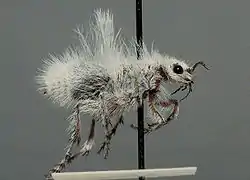Dasymutilla gloriosa
Dasymutilla gloriosa, sometimes referred to as the thistledown velvet ant,[1][2] is a member of the genus Dasymutilla. Only females are wingless, as in other mutillids. It ranges from Utah, Nevada, California, Arizona, New Mexico, Texas and south into Mexico.
| Dasymutilla gloriosa | |
|---|---|
 | |
| Female | |
 | |
| Male | |
| Scientific classification | |
| Kingdom: | |
| Phylum: | |
| Class: | |
| Order: | |
| Suborder: | |
| Superfamily: | |
| Family: | |
| Subfamily: | Sphaeropthalminae |
| Genus: | |
| Species: | D. gloriosa |
| Binomial name | |
| Dasymutilla gloriosa (Saussure, 1868) | |
| Synonyms | |
|
Mutilla gloriosa Saussure 1868 | |
Rather than having aposematic coloration like other mutillids, the females of this species are camouflaged by their resemblance to the fruit of Creosotebush, which occurs in the same habitats. However, this species' coloration appears to be primarily an adaptation to hot desert conditions instead of predation pressure; their internal and external body temperature are less compared to orange Dasymutilla species in the same habitat.[2]
References
- "Species Dasymutilla gloriosa". Retrieved 2008-09-13.
- Wilson, Joseph S.; Sidwell, Jeni Sage; Forister, Matthew L.; Williams, Kevin A.; Pitts, James P. (2020-07-29). "Thistledown velvet ants in the desert mimicry ring and the evolution of white coloration: Müllerian mimicry, camouflage and thermal ecology". Biology Letters. 16 (7): 20200242. doi:10.1098/rsbl.2020.0242.
- Evans, Arthur V. (2007). Field Guide to Insects and Spiders of North America. Sterling Publishing Co. p. 371. ISBN 978-1-4027-4153-1.